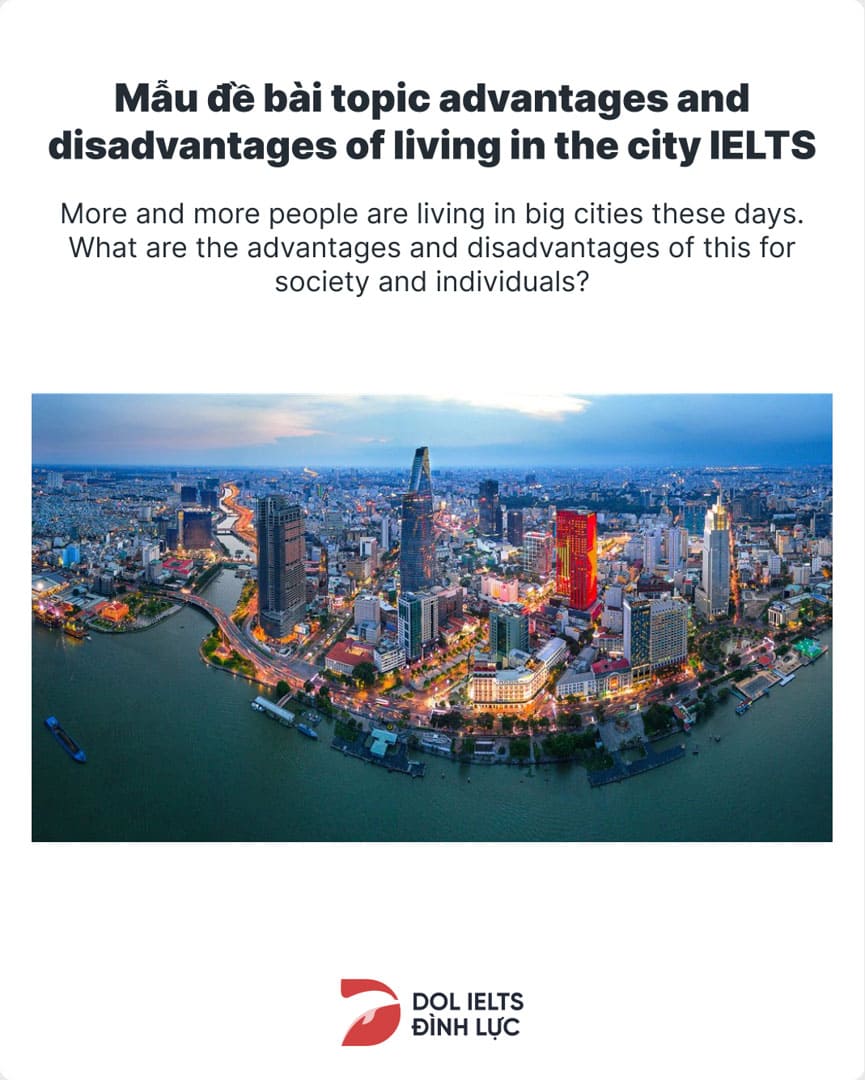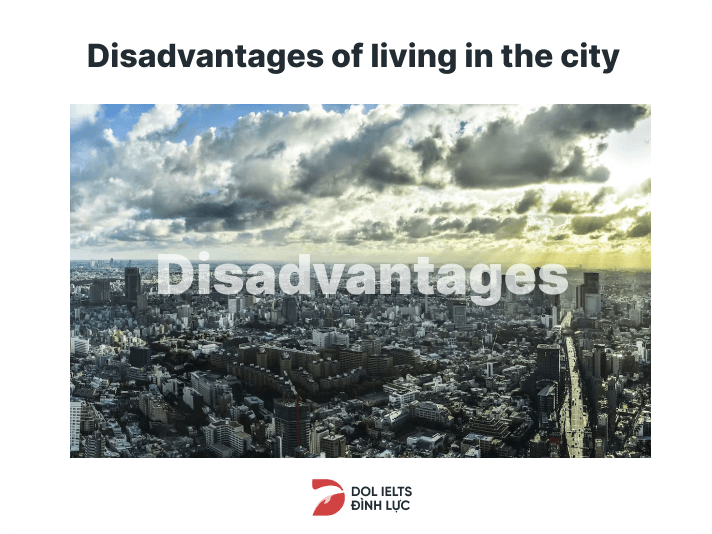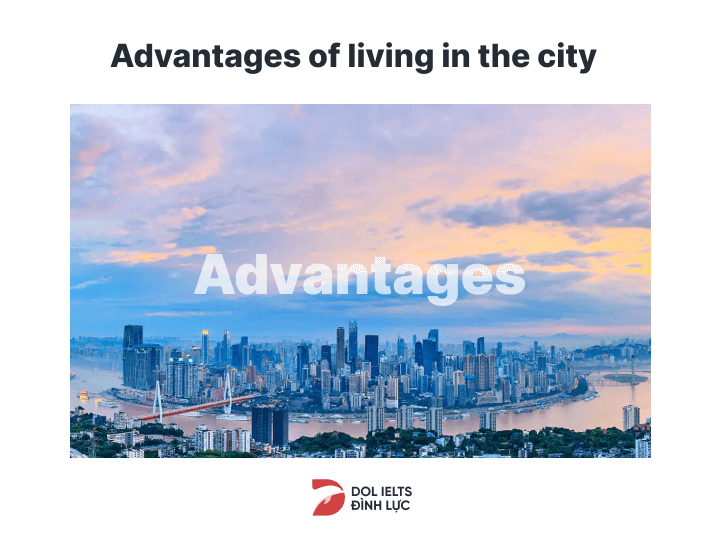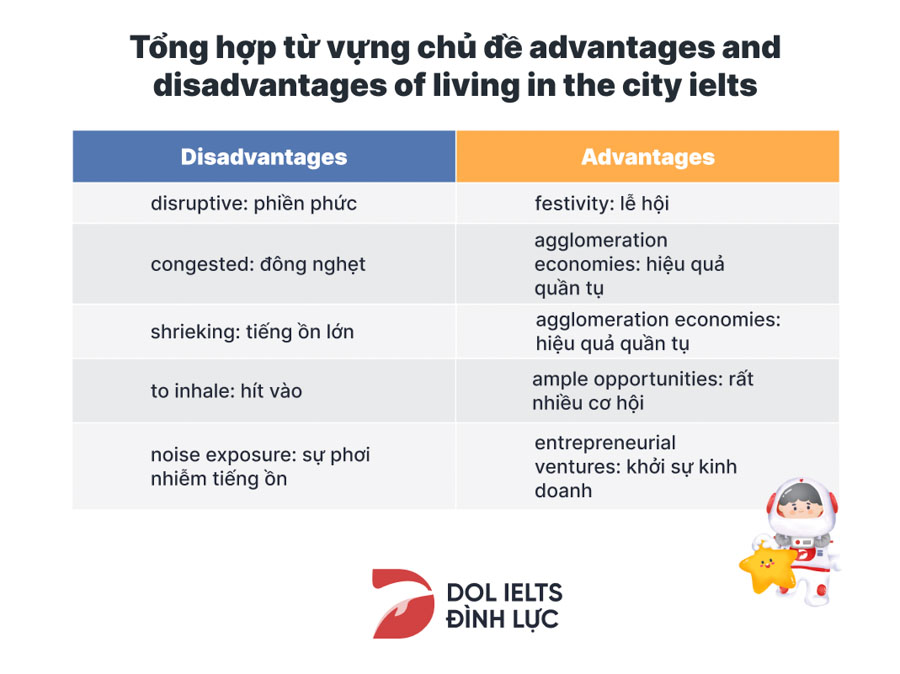IELTS Writing: Advantages & Disadvantages of living in the city
Hàng nóng từ nhà DOL, 7 bài samples authentic về chủ đề advantages and disadvantages of living in the city trong IELTS writing task 2.
DOL IELTS Đình Lực
Oct 15, 2022
2 mins read

Table of content
1. Disadvantage
2.
3.
4.
5.
6.
7.
Câu hỏi thường gặp:
More and more people are living in big cities these days. What are the advantages and disadvantages of this for society and individuals?

1. Disadvantage
It is reported that there is a rising number of people residing in metropolitan areas. Even if work prospects are more abundant in these areas, the quality of city life would still be unpleasant due to living expenses and noise levels being substantially higher.
On the one hand, major cities provide both a significant amount of employment and higher average salaries. With corporations dominating the city skyscrapers, it is impossible to not find work. Statistics from New York City demonstrate that inhabitants here have ten times more job prospects than those in the neighboring suburbs and smaller towns. Additionally, greater earnings are also another reason why workers are attracted to large cities. High-skilled workers tend to concentrate in urban centers because they can accumulate valuable experiences that are not available elsewhere. This skilled workforce is, of course, the target of agglomeration economies which are often willing to pay higher wages.
The increased cost of living, on the other hand, is the first disadvantage that people typically evaluate when considering relocating to a city. Major cities always have vastly higher living expenses than their surrounding suburbs. Places such as San Francisco and Los Angeles consistently have the highest accommodation costs in the United States. In these cities, basic living expenditures such as rent, utilities, food, beverages, and gasoline tend to be much greater. Secondly, metropolitan regions also have higher noise exposure. Major cities have far more inhabitants and traffic, which adds to the noise, as do trains and neighboring airports with shrieking planes arriving and departing. Special events, such as musical concerts and tournaments, can also render a neighborhood more disruptive and congested.
In conclusion, although living in bigger cities provides greater job opportunities, the living experience would still be undesirable due to the exorbitant living costs.
(296 words)
Từ vựng/cấu trúc hay | Ý nghĩa |
to reside in | live in - sống ở |
metropolitan areas | khu vực đô thị |
abundant | quá đủ đến mức thừa |
work prospect | tiền đồ |
skyscraper | tòa nhà chọc trời |
accumulate | tích lũy |
agglomeration economies | Hiệu quả quần tụ - Lợi ích thường xuất hiện ở các khu vực thành thị do các công ty thường ở gần nhau, dẫn tới giảm chi phí vận chuyển => Tăng profit. |
noise exposure | sự phơi nhiễm tiếng ồn |
shrieking | gây tiếng ồn lớn |
render somebody/something adj | Làm ai đó adj |
disruptive | làm phiền |
congested | đông nghẹt |
exorbitant living costs | chi phí sống đắt đỏ |
2. Disadvantage
According to estimates, the number of individuals residing in urban regions is increasing. Even though people can have a wider range of activities living in cities, it has significant drawbacks due to the high noise and air pollution levels.
On the one hand, major cities provide a plethora of enjoyable activities and ways to meet new people. There is always plenty to do in a large city to keep people of all interests entertained. Metropolises like Las Vegas, Bangkok, or Tokyo, for instance, feature vibrant nightlife, a variety of food to taste, festivities, and sporting events. Furthermore, these large metropolises also often come with millions of residents from varied origins and backgrounds. As such, meeting new individuals who share similar interests and passions can be incredibly exciting.
From another perspective, however, metropolitan regions suffer from higher levels of noise exposure and air pollution. Firstly, major cities have a significant number of inhabitants, which increases noise. General transportation modes like trains, buses, and airplanes also contribute to noise. Downtown districts in New York City, for example, are loud and crowded virtually twenty-four hours a day. Secondly, most urban dwellers worldwide are inhaling unhealthy levels of pollution. Ambient fine particle air pollution and nitrogen dioxide are the two primary pollutants that are especially notable in urban environments. As both of these are linked to the aggravation of asthma symptoms and other lung-related problems, city life is extremely harmful.
In conclusion, living in a city may provide for a broader variety of activities, but there are also substantial negatives owing to the increased rates of air and noise pollution.
(267 words)
Từ vựng/cấu trúc hay | Ý nghĩa |
to provide a plethora of N | cung cấp rất nhiều N |
vibrant nightlife | lối sống nhộn nhịp về đêm |
festivity | lễ hội |
virtually | gần như 100% |
dwellers | người sống ở đâu đó |
to inhale | hít vào |
Ambient | xung quanh |
aggravation of illness/bad situation | sự tệ đi |
owing to | because of |
3. Disadvantage
DOL dừng bạn một tý, trước khi đọc tiếp, bạn nhớ để ý những cách paraphrase Introduction của từng samples để tích lũy nhiều cách viết không chỉ cho đề advantages and disadvantages of living in the city mà còn các đề khác trong IELTS nhé.

Today, the urban population is growing increasingly. Whilst individuals have more options for commuting and job opportunities, the lack of green space and living space has significant drawbacks.
On the one hand, larger cities provide greater commuting alternatives and work prospects. Public transit in cities is typically a viable option for driving oneself and coping with traffic and parking issues. In Tokyo, for instance, certain public transportation choices, such as subways and buses, are also quite affordable and free the locals from the hassle of driving. The public transit system here also has connecting routes to international airports, which is particularly convenient for professional business travelers. In addition, there are also countless types of jobs in urban areas. These locations often provide ample opportunities for employment and entrepreneurial ventures. The possibilities can go from part-time and full-time positions in offices to retail and service industry jobs. Hence, urban areas have long been regarded as diverse job hubs.
The lack of living and green space, on the other hand, is a huge deterrent to individuals coming to cities. Most residents in larger cities often reside in apartments, which can be rather modest, if not tiny. It is also atypical to have an outside space such as a yard or terrace. Even though there are residences with open-air gardens in urban areas, they are considered highly luxurious. Living in the city, therefore, entails accepting the fact that one will be living in an apartment complex with neighbors on the opposite side of the walls. People in New York City, for example, may wander for miles before stumbling across any green area. In actuality, Central Park is commonly regarded as the communal "garden" for thousands of households.
In conclusion, despite the fact that people have more career options and transportation alternatives, the shortage of space and vegetation in cities continues to provide severe drawbacks.
(311 words)
Từ vựng/cấu trúc hay | Ý nghĩa |
commuting alternatives | hình thức di chuyển |
Public transit | hệ thống phương tiện công cộng |
hassle | tình huống khó chịu/khó khăn |
ample opportunities | rất nhiều cơ hội |
entrepreneurial ventures | khởi sự kinh doanh |
deterrent to someone or something | sự cản trở cho ai hoặc cái gì đó |
atypical | not typical |
entail something | buộc phải bao gồm cái gì |
stumble across something | tìm thấy thứ gì một cách ngẫu nhiên/bất ngờ |
complex | tập hợp các tòa nhà cùng loại |
4. Disadvantage
In the modern world, the population of urban regions is growing. Even though these areas have a plethora of free activities and shopping options, the increased living costs and crime rates make these places unappealing to reside in.
On the one hand, major cities feature plenty of free tourist opportunities as well as retail complexes. Firstly, everything including cycling in a park, window shopping, visiting art exhibits on free entry days, and enjoying the scenery downtown, is free, and one could easily spend an entire day being active. Individuals may occupy themselves at these amazing places, making the most of their city-living experience. Furthermore, shopping in the city offers a diverse range of choices. Within a relatively small radius, shop-goers would discover everything from traditional, larger-brand retailers with trendy, fashionable outfits to modest, artisan craft businesses, specializing in handcrafted, customized apparel.
Increased living expenses and crime rates, on the other hand, are significant deterrents to people migrating to large cities. Economic vitality has been more concentrated in a few favorable locales. As a result, these areas attract a disproportionate part of the country's wealth as well as the world's wealthiest inhabitants. As this group of people competes with each other in property purchases, they unintentionally drive the living costs up even more, which will soon no longer be affordable to less privileged people. Large cities are also more crime-prone, rendering them dangerous places to inhabit. This is logical from a statistical standpoint, as the urban population is extremely dense and the aforesaid riches attract criminals. Urban areas are also where there are higher numbers and more obvious cases of social and economic inequalities, which frequently trigger criminal behaviors.
In conclusion, despite the abundance of free activities and shopping alternatives major cities provide, the growing expense of living and high crime rates make them undesirable places to live.
(307 words)
Từ vựng/cấu trúc hay | Ý nghĩa |
unappealing | không hấp dẫn |
to occupy oneself at place | giết thời gian/làm mình bận rộn tại đâu |
make the most of something | tận hưởng cái gì |
artisan craft businesses | doanh nghiệp bán đồ thủ công |
economic vitality | sự hưng thịnh kinh tế |
disproportionate part | một phần không cân xứng (quá lớn hoặc quá nhỏ) |
crime-prone | tỷ lệ phạm tội cao |
aforesaid/aforementioned | đã nhắc tới |
5.Advantage

The population of urban areas is increasing in the modern world. Although these areas suffer from a lack of space, which leads to unhealthy lifestyles, improved employment, and educational prospects make them ideal locations to settle.
On the one hand, city dwellers struggle to maintain a healthy lifestyle while yet finding adequate room to live comfortably. First of all, most apartments in major cities are typically tiny while it is relatively rare to have extra outside space, such as a lawn or a yard. Thus, being creative in utilizing the space properly is one of the main traits for living a happy life in the city. In addition, city life is also commonly associated with a decrease in physical exercise. On top of limited green spaces, the urban lifestyle leaves people with little or no time to exercise. Only those who are serious about maintaining their health through exercise would search for gyms.
On the other hand, big cities are attractive places to settle due to better job and educational opportunities. There are more employment and learning possibilities in cities. Although the job market is considerably more competitive, there are numerous employment possibilities and a wide array of jobs in which to participate. There are even more occupations available for educated and high-skilled workers, ranging from labor positions, clerks, and customer service to jobs such as engineers, physicians, and scientists. Furthermore, cities provide greater educational prospects as well as a plethora of courses and institutions. Families with children may also find it more advantageous to relocate to the city, where they will be exposed to a more advanced and modern education system.
In conclusion, despite the fact that larger cities are vulnerable to a shortage of space, which promotes unhealthy lifestyles, greater employment and educational opportunities make these locations desirable to live in.
(303 words)
Từ vựng/cấu trúc hay | Ý nghĩa |
wide array of N | a lot of different things |
to relocate | chuyển đến |
to be vulnerable to something | dễ bị ảnh hưởng xấu bởi something |
6. Advantage
In today's world, the population of metropolitan regions is growing. Although these places have traffic and pollution problems, their cultural richness and vibrant communities make them attractive places to live.
On the one hand, metropolitan regions have enormous traffic and pollution issues. First of all, the city's biggest concern is traffic, especially in central business districts. This is because a substantial proportion of the urban population prefers private transportation to public transportation for convenience reasons. As a result, avoiding traffic in metropolitan areas is impossible. Because of this nuisance, city dwellers must constantly leave their houses early for work. In addition, pollution is also unavoidable when discussing metropolitan life. Some of the causes of city air, water, and noise pollution include high carbon emission rates, contaminated drinking water, and excessive decibel levels. In cities such as Los Angeles, other sources of pollution also include the growing use of motorized transportation and the massive quantity of waste generated.
On the other hand, cities are desirable locations to reside in because of their thriving communities and diversity of cultures. The reason is that people from varied ethnic backgrounds commonly flock to certain mega-cities. In these places, individuals would have more opportunities to explore other cultures. As one becomes more accustomed to the city lifestyle, the chances of forming friendships and developing meaningful connections increase. Cities are the perfect places for people to develop their group of connections and networks, thus gaining better life experiences. Furthermore, leading a busy life in a fast-paced metropolis may be the key to finding true happiness as people feel they are steadily working towards their dreams. According to research, there is a positive correlation between people's levels of life satisfaction and the pace at which they spend their lives.
In conclusion, while cities often have traffic and pollution issues, their cultural diversity and lively communities make them ideal locations to live.
(314 words)
Từ vựng/cấu trúc hay | Ý nghĩa |
cultural richness | giàu văn hóa |
vibrant communities | những cộng đồng đầy sức sống |
enormous | khổng lồ |
substantial proportion of | một phần lớn của cái gì |
nuisance | sự phiền toái |
contaminated | ô nhiễm |
excessive | quá mức |
motorized transportation | phương tiện giao thông gắn động cơ |
varied ethnic backgrounds | đa dạng sắc tộc |
to flock to | đi đến đâu đó với số lượng lớn |
become accustomed to something | trở nên quen thuộc với thứ gì đó |
fast-paced | tốc độ (thay đổi) nhanh |
7. Advantage
The population of urban areas is increasing in today's world. Although this tendency has some environmental risks, people continue to migrate to cities since they provide better overall facilities and healthcare.
On the one hand, metropolitan areas pose a threat to the environment. Even while cities cover only a small percentage of the Earth's surface, they have an extraordinary concentration of population, industry, and energy usage. This causes massive local pollution and environmental deterioration since they are also large producers of greenhouse gas emissions, trash, and pollutant emissions in water and air. Furthermore, cities' ecological footprints extend well beyond their urban boundaries to forests, farms, rivers, and other surfaces to provide food and water to their population. Cities are, therefore, hubs of consumerism, which have a detrimental influence on the surrounding rural, regional, and global ecosystems as they deplete natural resources.
On the other hand, people still flock to major cities because of their superior general facilities and healthcare. Cities frequently have hospitals and nursing homes with skilled doctors and good medication to care for us when we have illnesses. Moreover, numerous gyms and parks would also further encourage people to stroll and exercise. With growing environmental concerns, most urban areas now also have pollution control departments to better manage waste and strong sewage systems to keep sanitary. High-tech cities, such as Berlin and Tokyo, have also invested in solar energy, and solar panels are currently being installed on several skyscrapers.
In conclusion, despite certain environmental risks, people still relocate to metropolises due to their favorable systems for facilities and medical services.
(262 words)
Từ vựng/cấu trúc hay | Ý nghĩa |
tendency | xu hướng |
pose a threat to something | đe dọa cái gì đó |
environmental deterioration | sự xuống cấp môi trường |
ecological footprints | dấu chân sinh thái |
hubs of consumerism | trung tâm của chủ nghĩa tiêu dùng |
to stroll | đi bộ thư thái |
keep sanitary | giữ vệ sinh |
high-tech cities | các thành phố có công nghệ cao |
Nếu bạn đã hoàn thành bài luận của mình với 250 từ, bạn không cần thêm bất kỳ chi tiết bổ sung nào trong phần kết luận của bài viết. Nếu chưa đủ số từ, hãy thêm một số chi tiết, chẳng hạn như trình bày lại quan điểm của bạn và tóm tắt điểm chính của bài luận. Hai hoặc ba câu có thể đủ cho phần kết luận.
https://www.kanan.co/ielts/writing/task-2/advantages-and-disadvantages-essay/

Câu hỏi thường gặp:
Gợi ý thi viết IELTS: Những thuận lợi và khó khăn khi sống ở thành phố là gì?
Việc sinh sống ở thành phố đem lại những thuận lợi và khó khăn nhất định. Cụ thể như sau: Thuận lợi:
Tiếp cận các dịch vụ dễ dàng
Nhiều cơ hội việc làm, học tập
Nhu cầu giải trí dễ dàng được thoả mãn
Giao thông công cộng ở thành phố được cải tiến rất nhiều so với nông thôn
Được tiếp xúc với nhiều nền văn hoá của các vùng miền khác nhau
Khó khăn:
Chi phí sinh hoạt đắt đỏ
Tỉ lệ cạnh tranh trong công việc cao
Áp lực dành cho người trẻ ngày càng tăng cao
Ô nhiễm tiếng ồn gia tăng
Tỷ lệ tội phạm cao hơn ở nông thôn
Chi phí bảo hiểm ô tô đắt hơn
Thiếu không gian sinh sống cho lượng lớn người lao động
Thiếu bãi đậu xe
Gợi ý bài viết IELTS: Những vấn đề mà người dân thành phố phải đối mặt là gì?
Có khá nhiều vấn đề nan giải mà người dân ở thành phố phải đối diện. Đó là:
Hệ thống thoát nước kém, dễ gây ngập lụt khi gặp mưa lớn
Tình trạng tắc nghẽn giao thông thường xuyên
Tình trạng thiếu nước sạch, thiếu điện để sinh hoạt, làm việc
Vệ sinh môi trường đô thị vẫn chưa được xử lý triệt để
Lượng rác thải từ đô thị là rất lớn
Tỷ lệ thất nghiệp ở thành phố vẫn còn cao
Các khu nhà ổ chuột, nhà tạm bợ vẫn còn tồn tại
An ninh đô thị vẫn còn là 1 vấn đề cần củng cố
Thi viết IELTS: Vì sao mọi người thường thích ở lại các thành phố?
Ngày nay, xu hướng di cư đến sinh sống tại thành phố không phải là hiếm. Bởi hầu hết mọi người đều muốn trải nghiệm, tận hưởng các dịch vụ và cơ sở vật chất tốt hơn. Từ đó nâng cao chất lượng cuộc sống. Hơn nữa, nền giáo dục ở thành phố cũng được chú trọng củng cố hơn rất nhiều so với nông thôn. Việc sinh sống tại thành phố còn giúp người dân có cơ hội tiếp cận với khoa học, công nghệ, kỹ thuật tiên tiến, hiện đại, bắt kịp xu hướng phát triển của thế giới.
Phần thi viết IELTS: Một thành phố cần những yếu tố gì để phát triển?
Để trở thành 1 thành phố có tốc độ phát triển vượt bậc, cần có sự tiến triển về mặt kinh tế. Chính quyền thành phố nên khuyến khích các doanh nghiệp đổi mới và cập nhật xu hướng của thế giới. Đồng thời giải quyết vấn đề việc làm cho người dân. Ngoài ra, khi hệ thống giáo dục tại thành phố được củng cố, đời sống người dân được chăm lo thì tình hình an ninh đô thị cũng theo đó mà ổn định theo.
DOL hy vọng là bài viết trên đã giúp bạn biết nhiều hơn về chủ đề advantages and disadvantages of living in the city trong IELTS task 2 để có thể áp dụng tự học hiệu quả.
Nếu có bất kỳ thắc mắc gì về IELTS Speaking hay các kỹ năng, đừng ngần ngại mà liên hệ DOL qua các kênh sau bạn nhé: website, Facebook. Chúc bạn thành công.
Table of content
1. Disadvantage
2.
3.
4.
5.
6.
7.
Câu hỏi thường gặp:
